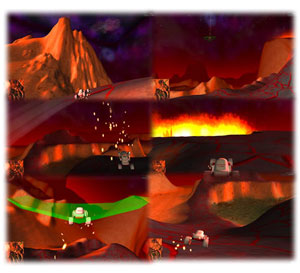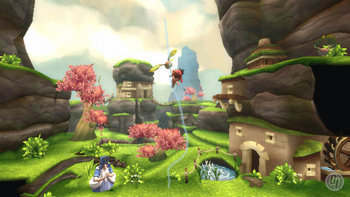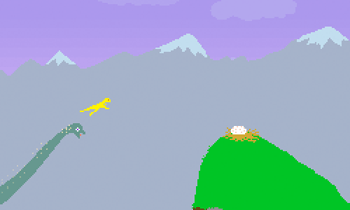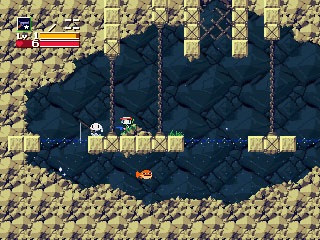
I found this free in-browser game last night called Mars
Explorer. Designed by a remarkable 18-year-old chap called Aubrey Falconer,
Mars Explorer puts you in control of a space buggy in a small 3D environment
that is meant to resemble Mars. The supposed draw is the online multiplayer
laser tag mode, but I couldn’t connect to any games. The alternative is a
charmingly aimless single player exploration mode that reminded me of playing
Hunter on the Amiga. What really makes Mars Explorer is this looped piece of
music that wouldn’t be out of place over the opening or end credits of a Werner
Herzog film.
You can drive around with the cursor keys, but when you
press the space bar something special happens: your buggy spreads a pair of
green, semi-transparent wings. Press the down key and your strange little craft
will take off. In flight, controls are really responsive, and you can glide
around the very limited environment to your heart’s content. If you like Herzog
films and nice gliding physics, try playing Mars Explorer.
PC users can play the game here:
http://aubreyfalconer.com/view-238
Mac users can download the dashboard version here:
http://www.apple.com/downloads/dashboard/games/marsexplorer_atidesign.html

 Retro GT has teamed up with
Retro GT has teamed up with  Paradroid was excellent. Geography homework competed with it in the manner of plankton competing with a blue whale, and Andrew Braybrook – the game’s creator – must bear at least some responsibility for a wave of poor O Level results in the mid 1980’s. For those of you unfamiliar with this bona fida classic, Paradroid was a simple game, in which the player adopted the guise of a weak but clever low level robot – an Influence Droid – placed aboard a series of rogue space cruiser fleet in which some kind of crazy android mutiny has taken place. They were robo freighters on the way to Beta Ceti system by all accounts, but that wasn’t really important, as your task was to kill everything. Or was it? Yes. Well no. Well yes and no, and kind of. Your Influence Droid had about as much combative power as the Commodore 64 you were probably playing the game on but – and here was Paradroid’s great hook – it had the ability to take over the brain of other robots, effectively gaining mad power ups. This game-within-a-game took place amid a lateral grid of backgammon-meets-Connect 4 hardwiring complete with circuit splitters and logic gates. You have one side, the host robot has the other. Whoever controls the most circuits after an allotted time is deemed the winner. If it’s you, you get a shiny new set of weapons and armaments. If it isn’t, you run the risk of being consigned to on-board litter duty for ever.
Paradroid was excellent. Geography homework competed with it in the manner of plankton competing with a blue whale, and Andrew Braybrook – the game’s creator – must bear at least some responsibility for a wave of poor O Level results in the mid 1980’s. For those of you unfamiliar with this bona fida classic, Paradroid was a simple game, in which the player adopted the guise of a weak but clever low level robot – an Influence Droid – placed aboard a series of rogue space cruiser fleet in which some kind of crazy android mutiny has taken place. They were robo freighters on the way to Beta Ceti system by all accounts, but that wasn’t really important, as your task was to kill everything. Or was it? Yes. Well no. Well yes and no, and kind of. Your Influence Droid had about as much combative power as the Commodore 64 you were probably playing the game on but – and here was Paradroid’s great hook – it had the ability to take over the brain of other robots, effectively gaining mad power ups. This game-within-a-game took place amid a lateral grid of backgammon-meets-Connect 4 hardwiring complete with circuit splitters and logic gates. You have one side, the host robot has the other. Whoever controls the most circuits after an allotted time is deemed the winner. If it’s you, you get a shiny new set of weapons and armaments. If it isn’t, you run the risk of being consigned to on-board litter duty for ever.
 After a decade of waiting, Street Fighter 4 is soon to be released and we are literally about to explode with excitement when we say that RetroGT will be among the first to play the completed UK arcade version!
After a decade of waiting, Street Fighter 4 is soon to be released and we are literally about to explode with excitement when we say that RetroGT will be among the first to play the completed UK arcade version!
 It’s going to be an incredible event, with the first completed version of Street Fighter 4, as well as the first chance to play Super Street Fighter 2 Turbo HD Remix in the UK.
It’s going to be an incredible event, with the first completed version of Street Fighter 4, as well as the first chance to play Super Street Fighter 2 Turbo HD Remix in the UK. 
 I downloaded Lost Winds yesterday and completed it this afternoon. Lost Winds is an adventure platformer made by Frontier Developments for Nintendo’s WiiWare series. While the world and characters are in 3-D, the game controls in 2-D, with sideways movement mapped to the Nunchuk. Instead of a jump button, you use the motion control of the Wii Remote to create gusts of wind around the player character, lifting him from platform to platform. It’s this innovative control scheme, rather than the story and the graphics, that really blew me away.
I downloaded Lost Winds yesterday and completed it this afternoon. Lost Winds is an adventure platformer made by Frontier Developments for Nintendo’s WiiWare series. While the world and characters are in 3-D, the game controls in 2-D, with sideways movement mapped to the Nunchuk. Instead of a jump button, you use the motion control of the Wii Remote to create gusts of wind around the player character, lifting him from platform to platform. It’s this innovative control scheme, rather than the story and the graphics, that really blew me away.
 Dino Run is a free flash side-scroller developed by Pixeljam. You are a yellow dinosaur trying to escape extinction, running and jumping from left to right, away from a wave of mutilation. The game is about timing your jumps and keeping up the momentum of your run, collecting bonuses, and most importantly hitching rides with pterodactyls. The world is lovingly rendered in a 4-bit style, with set-piece obstacles that will take your breath away. In the event that you crash into another dinosaur or fall down an awkward crater, you will hear the rumble of your impending doom, which takes the form of a wall of destruction that is always just behind you. When it catches up, everything gets darker and silhouetted, while meteors crash around you, creating dynamic obstacles for you to negotiate on the fly. Believe it or not, this game is really exhilarating once you get going, and the attention to detail in the art department keeps the journey from left to right interesting, and, dare I say it, quite beautiful.
Dino Run is a free flash side-scroller developed by Pixeljam. You are a yellow dinosaur trying to escape extinction, running and jumping from left to right, away from a wave of mutilation. The game is about timing your jumps and keeping up the momentum of your run, collecting bonuses, and most importantly hitching rides with pterodactyls. The world is lovingly rendered in a 4-bit style, with set-piece obstacles that will take your breath away. In the event that you crash into another dinosaur or fall down an awkward crater, you will hear the rumble of your impending doom, which takes the form of a wall of destruction that is always just behind you. When it catches up, everything gets darker and silhouetted, while meteors crash around you, creating dynamic obstacles for you to negotiate on the fly. Believe it or not, this game is really exhilarating once you get going, and the attention to detail in the art department keeps the journey from left to right interesting, and, dare I say it, quite beautiful.
 I was recently looking for freeware games I could play on my laptop. I would have been okay with a Tetris or Marble Madness clone, but I emerged with Dōkutsu Monogatari (Cave Story), a non-linear platformer that evidently took the Internet by storm when it arrived in 2004. I’m sure some people reading this already know about and have played Cave Story, but for those that haven’t, you must. The game was developed over a period of five years by Daisuke Amaya (codename: Pixel), who, in a rare and oblique interview described himself as a programmer who rode his bike to work everyday, “standing the whole way.” He wrote the music first, and made the game up as he went along.
I was recently looking for freeware games I could play on my laptop. I would have been okay with a Tetris or Marble Madness clone, but I emerged with Dōkutsu Monogatari (Cave Story), a non-linear platformer that evidently took the Internet by storm when it arrived in 2004. I’m sure some people reading this already know about and have played Cave Story, but for those that haven’t, you must. The game was developed over a period of five years by Daisuke Amaya (codename: Pixel), who, in a rare and oblique interview described himself as a programmer who rode his bike to work everyday, “standing the whole way.” He wrote the music first, and made the game up as he went along.
